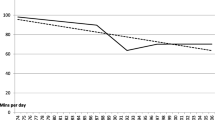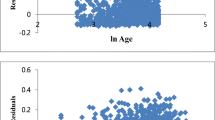Abstract
The upward trend in Americans’ weight has precipitated research aimed at identifying its underlying causes. In this paper we examine trends in Americans’ time spent eating in an attempt to gain a better understanding of Americans’ changing eating habits and their predictors. Data used in the analyses come from four national time use surveys conducted between 1975 and 2007. We find that Americans’ total eating time has risen over the past 30 years largely because of increases in secondary eating time. Multivariate analyses reveal that shifts over time in wage rates, food prices, household income, and racial/ethnic composition may be contributing to Americans’ changing eating patterns.

Similar content being viewed by others
References
American Time Use Survey Eating and Health Module Data. (2008). U.S. Bureau of Labor Statistics. [cited November 10]; Available from: http://www.bls.gov/tus/ehmintcodebk.pdf.
Arterburn, D. E., Maciejewski, M. L., & Tsevat, J. (2005). Impact of morbid obesity on medical expenditures in adults. International Journal of Obesity, 29(3), 334–339.
Becker, G. S. (1965). A theory of the allocation of time. Economic Journal, 75(299), 493–517.
Becker, G. S. (1991). A treatise on the family, enlarged edition. Cambridge: Harvard University Press.
Bellisle, F., & Dalix, A. M. (2001). Cognitive restraint can be offset by distraction, leading to increased meal intake in women. American Journal of Clinical Nutrition, 74(2), 197–200.
Bianchi, S. M., Robinson J. P., & Milkie M. A. (Eds.). (2006). Changing rhythms of American family life. Russell Sage Foundation: New York.
Bryant, W. K., & Zick, C. D. (2006). The economic organization of the household (2nd ed). New York: Cambridge University Press.
Centers for Disease Control and Prevention. (2009). Improving your eating habits. [cited 2009 April 20]; Available from: http://www.cdc.gov/healthyweight/losing_weight/eating_habits.html.
Fontaine, K. R., Redden, D. T., Wang, C., Westfall, A. O., & Allison, D. B. (2003). Years of life lost due to obesity. JAMA: The Journal of the American Medical Association, 289(2), 187–193.
Hassan, M. K., Joshi, A. V., Madhavan, S. S., & Amonkar, M. M. (2003). Obesity and health-related quality of life: A cross-sectional analysis of the US population. International Journal of Obesity and Related Metabolic Disorders 27(10): 1227.
Juster, F. T., Courant, P., Duncan, G. J., Robinson, J. P., & Stafford, F. P. (2001). Time use in economic and social accounts. Ann Arbor: Interuniversity Consortium for Political and Social Research.
Muennig, P., Lubetkin, E., Jia, H., & Franks, P. (2006). Gender and the burden of disease attributable to obesity. American Journal of Public Health, 96(9), 1662–1668.
National Center for Health Statistics. (2008). Prevalence of overweight and obesity among adults: United States, 2003–2004. September 9, 2008. [cited 2008 November 12]; Available from: http://www.cdc.gov/nchs/products/pubs/pubd/hestats/overweight/overwght_adult_03.htm.
National Institute of Diabetes Digestive and Kidney Diseases. (2008) Healthy eating and physical activity across your life span. 2008; [cited 2009 April 20]; Available from: http://www.win.niddk.nih.gov/publications/better_health.htm#whatis.
Robinson, J. P. (1985). The validity and reliability of diaries versus alternative time use measures. In F. T. Juster & F. P. Stafford (Eds.), Time, goods, and well-being (pp. 33–62). Ann Arbor, MI: Institute for Social Research, University of Michigan.
Robinson, J. P. (2007). Americans’ use of time, 1985. Ann Arbor, MI: Interuniversity Consortium for Political and Social Research.
Robinson, J. P., Bianchi, S. M., & Presser, S. (2001). Family interaction, social capital trens in time use, 1998–99. Ann Arbor, MI: Inter-university Consortium for Political and Social Research.
Robinson, J. P., & Godbey, G. (1997). Time for life: The surprising ways Americans use their time. University Park, PA: The Pennsylvania State University Press.
Stroebele, N., & De Castro, J. M. (2004a). Effect of ambience on food intake and food choice. Nutrition, 20(9), 821–838.
Stroebele, N., & de Castro, J. M. (2004b). Television viewing is associated with an increase in meal frequency in humans. Appetite, 42(1), 111–113.
Stroebele, N., & de Castro, J. M. (2006). Listening to music while eating is related to increases in people’s food intake and meal duration. Appetite, 47(3), 285–289.
The Henry J. Kaiser Family Foundation. (2009). Overweight and obesity rates for adults by race/ethnicity, 2008. Available: http://www.statehealthfacts.org/comparebar.jsp?ind=91&cat=2.
Thorpe, K. E. (2006). Factors accounting for the rise in health-care spending in the United States: The role of rising disease prevalence and treatment intensity. Public Health, 120(11), 1002–1007.
U.S. Bureau of Labor Statistics. (2008a). American time use survey users’ guide. U.S. Bureau of Labor Statistics. [cited 2008 May 27]; Available: http://www.bls.gov/tus/atususersguide.pdf.
U.S. Bureau of Labor Statistics. (2008b). Highlights of women's earnings in 2007. In Department of Labor (Ed.). Washington DC.
U.S. Census Bureau. (2007). The 2007 statistical abstract: The national data book. Washington DC.
Wee, C. C., Phillips, R. S., Legedza, A. T., Davis, R. B., Soukup, J. R., Colditz, G. A., et al. (2005). Health care expenditures associated with overweight and obesity among US adults: Importance of age and race. American Journal of Public Health, 95(1), 159–165.
Author information
Authors and Affiliations
Corresponding author
Rights and permissions
About this article
Cite this article
Zick, C.D., Stevens, R.B. Time Spent Eating and Its Implications for Americans’ Energy Balance. Soc Indic Res 101, 267–273 (2011). https://doi.org/10.1007/s11205-010-9646-z
Accepted:
Published:
Issue Date:
DOI: https://doi.org/10.1007/s11205-010-9646-z




